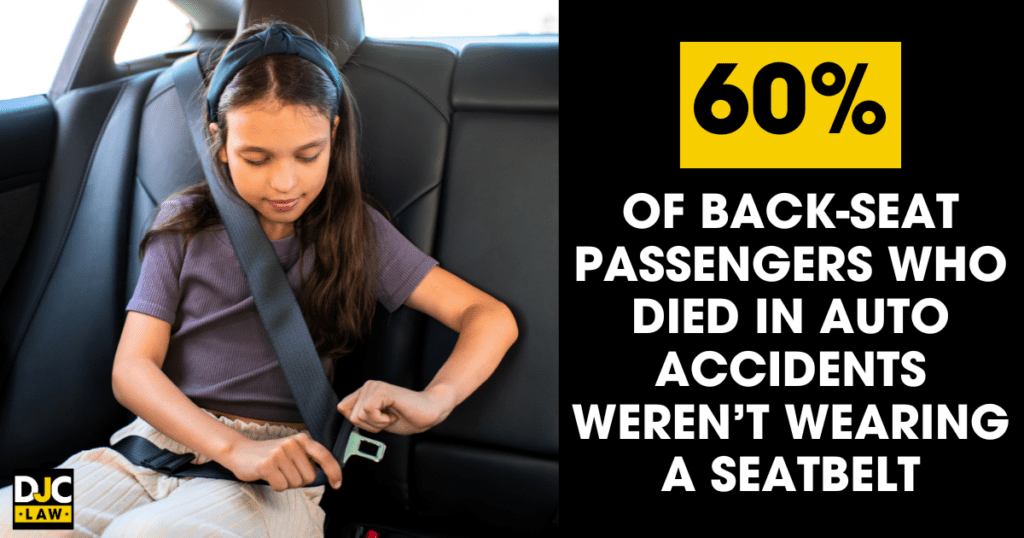Deciding whether your child should sit in the front seat can be a conundrum for parents. Laws exist in every state to determine the minimum age and weight requirement. However, the American Academy of Pediatrics (AAP) still recommends that children remain in the back seat until age 13.
Children are naturally more vulnerable to the impacts of auto accidents, with an average of three children being killed in crashes every day, per the National Highway Traffic Safety Administration (NHTSA). In short, the rear seat remains the safest place for your child to be.
If your child is injured in a crash, seeking legal guidance can be crucial. A car accident lawyer in Austin can help you understand your rights and pursue compensation for medical expenses and damages.
In this guide, we’ll discuss the issues surrounding child car seats and when your child should sit in the front seat to help parents make an informed decision on the safety of their smallest passengers.
Key Takeaways
-
Child safety experts recommend that children be at least 13 before sitting in the front seat.
-
No federal laws exist on when children can sit in the front seat, but 22 states have age, height, and weight requirements on when kids can be in the front. All states provide strong recommendations, however.
-
The safest place for children is the rear, and they should sit in a seat appropriate to their age, height, and weight, whether it’s a rear-facing car seat, forward-facing car seat, or booster seat.
-
In states with child front passenger laws, drivers can be pulled over and issued fines for allowing their children to sit in the main passenger seat, which could impact your insurance premiums.
-
Your insurance premiums won’t be affected if you allow your kids to sit in the front unless you are breaking the law and are cited.
-
Children in the front seat incur significant safety risks due to the power of airbags, increased impact, and a lack of front passenger air bag compatibility with child restraint systems and booster seats.
-
If your child is injured in an auto accident, they have the right to receive a settlement for their injuries, but their parents must file on their behalf. Speak to a lawyer to learn more about your legal rights.
How Old Can You Be to Sit in the Front Seat?
Child safety experts recommend waiting until a child is 13 before putting them in the front seat. Legally, every state has its own minimum age and weight requirements. However, 28 states have no laws at all, thus leaving the decision entirely to parents.
Even among states with laws on the issue, there’s a great deal of variation. For example, Texas requires that a child be at least eight years old before sitting in the front seat. On the other hand, Colorado only requires a child to be two and at least 20 pounds. Illinois is one such state with no law at all.
Despite the variation in laws, most states strongly recommend waiting until your child is 13 for safety reasons.
Exceptions to the Child Safety Seat Rule
Experts present exceptions to their recommendations that would allow a child under 13 to sit in the front seat, such as if all rear seats are occupied by children. However, according to state law, these exceptions don’t apply if the child in question is under the required age, height, or weight requirements.
Here’s a rundown of the exceptions provided by Safe Ride 4 Kids for children to sit in the front passenger seat:
-
If every rear seat is occupied by a child.
-
If your vehicle doesn’t have any back seats.
-
If your rear seats don’t have any shoulder restraints and your front seat has a booster seat.
-
If you don’t have space for three child restraints in the back.
Naturally, it’s recommended that you try to avoid getting into this situation entirely. Although the IIHS reports that the death rate among under-13s in car crashes has declined by 75% since 1975, it’s still dangerous for extremely young children to sit up front.
What are the Age and Weight Restrictions for Sitting in the Front?
No official weight limit exists for sitting in the car’s front seat, with the AAP and NHTSA focusing on age, which they recommend as 13. However, 22 states have laws on age, height, and weight requirements for sitting in the front of a passenger vehicle.
One example is California, which mandates that children be at least eight years old and taller than 57 inches to sit in the front. According to Safe in the Seat, another point to remember is that maturity is another factor parents must consider. They recommend that children be able to sit still and ensure that at all times:
-
Their keister is flush against the vehicle seat.
-
Their knees stay bent over the edges of the seat.
-
Their feet stay planted on the flow.
-
They can keep their lap belt sitting low across the top of their thighs.
-
Their shoulder belt remains between their neck and shoulder.
Although these requirements are strict, laws and recommendations on where children should sit in a vehicle are credited partly to the decline in the number of child fatalities in auto crashes. For example, in 2022, the National Safety Council reported that the number of deaths was lowest among the under-5s demographic.
Child Front Seat Laws by State
Approximately 55% of states have no laws controlling when a child can sit in the front. The rest of the states have no such laws but continue to provide recommendations to parents. There are no federal laws on the issue, so the issue remains up to each individual state.
What follows is a comprehensive list of child front seat laws by state:
States With No Child Passenger Seat Laws
-
Alabama
-
Alaska
-
Arizona
-
Arkansas
-
Connecticut
-
District of Columbia
-
Florida
-
Hawaii
-
Idaho
-
Illinois
-
Iowa
-
Kansas
-
Kentucky
-
Maryland
-
Massachusetts
-
Minnesota
-
Mississippi
-
Missouri
-
Montana
-
Nevada
-
New Hampshire
-
New York
-
North Dakota
-
Oklahoma
-
Oregon
-
Pennsylvania
-
South Dakota
-
Texas
-
Utah
-
West Virginia
States With Child Passenger Seat Laws
-
Age 2+ – Colorado, New Mexico, and Vermont require children to be aged two, with Colorado and Vermont mandating that children be at least 20 lbs.
-
Age 4+ – Michigan and Ohio legally require children to be at least four, with the latter also requiring children to be at least 40 lbs.
-
Age 5+ – North Carolina requires children to be over 40 lbs and at least five years old.
-
Age 8+ – California, Nebraska, Rhode Island, South Carolina, and Virginia require children to be at least eight, with California and New Jersey requiring children to be at least 57 inches tall.
-
Age 9+ – Tennessee and Wyoming both need children to be at least nine, with the former also including a 57-inch height requirement.
-
Age 12+ – Delaware requires children to be at least 65 inches, with Maine demanding that children be at least 100 lbs.
-
Age 13+ – Indiana, Louisiana, and Washington require children to be at least 13 unless there’s no backseat available. Wisconsin makes no exceptions and requires all children to be at least 13.
Are There Penalties for Allowing a Child to Sit in the Front Seat Prematurely?
Penalties exist for violating child passenger safety laws, but the exact penalties vary based on the state. Fines can range from as low as $10 to $500 for a first offense. In some cases, you may receive additional penalties, including points on your driving license, traffic safety education classes, and even increases in your insurance premiums.
Penalties are rarely significant for prematurely allowing a child to sit in the front seat, but it largely depends on the state. Most states take the position of educating parents on why their children should remain in the rear seat rather than opting for stringent punishments.
However, the issue isn’t necessarily about “getting away with it” but whether you’re doing what’s best for your child. Like seat belt laws, these laws aren’t designed to infringe upon your rights but to help you keep your children safe from harm.
What are the Federal Recommendations for Children Sitting in the Front Seat?
The U.S. Centers for Disease Control (CDC) provides recommendations for protecting children being transported in passenger vehicles, focusing on different age and size categories and what parents should do. For example, children from birth to ages 2-4 are recommended to remain in rear-facing seats, with older children transitioning into forward-facing car seats, booster seats, and, finally, the front seat.
The CDC’s key recommendation is to keep children buckled in the back seat until age 13 for the highest possible level of safety. Let’s go through the Federal recommendations for each age group:
Birth to Ages 2-4
Children in this category should remain in a rear-facing car seat until they exceed the height and weight limits of the seat, which you’ll be able to find in the owner’s manual. Above all, never place this seat in the front, as airbags present a serious danger to children in this position.
Until At Least Age 5
Once your child has outgrown the rear-facing car seat, you can move them to a forward-facing seat, which should include a harness and tether. Again, they should remain in this seat until they outgrow it, preferably until they reach their fifth birthday.
After Outgrowing the Forward-Facing Car Seat
Next, a child graduates to using a booster seat. They should continue to use the booster until they can fit into a lap and shoulder belt without one. Most children will reach this point between the ages of nine and 13.
Here’s what it means to fit a seatbelt properly without a booster seat:
-
The lap belt fits across the upper thighs.
-
The shoulder belt fits across the chest and shoulder.
Safety Risks for Children in the Front Seat
Children are at risk of sitting in the front seat, with serious injuries and fatalities being more common among children in this position. Powerful airbags, seatbelts that don’t fit properly, and higher impact forces for front-seat passengers contribute to the increased risk. Remember, children are naturally less resistant to injury than adults, which is why Federal requirements recommend not allowing minors to sit up front until the age of 13.
Why are Airbags Dangerous for Younger Passengers?
Airbags were designed to protect adults and teenagers from harm, but they were not designed to protect younger passengers or passengers using booster seats. The force of the airbags can result in serious injury and death for children, making them more dangerous than helpful if you’re involved in an accident.
Remember, your airbags may deploy even in low-speed crashes, and many drivers are surprised at the force behind the deployment. Airbags may deploy at speeds of 200 mph, which can injure anyone too close to the deployment.
Serious injuries may include:
-
Skull fractures
-
Rib fractures
-
Facial damage
-
Chest cavity damage
-
Burns from friction
Auto manufacturers are required to install front and side airbags for passenger safety, but they’re not required to make them compatible with child seats, as this would be impractical. Due to airbags not being designed for children in car seats or child restraint systems, airbags are liable to cause catastrophic injuries.
How Can You Ensure Safety for Kids Riding in the Front?
Parents should continue to take precautions after their child meets the recommended height, weight, and age requirements. Immature children in the front seat are a danger to everyone in the vehicle and other drivers, meaning parents must lead by example when it comes to buckling up and adopting safe sitting habits.
Follow the SAFER model for keeping your kids safe when they’re ready to ride in the front:
-
Seat – Ensure the front passenger seat is adjusted so that it’s as far back as possible from the dashboard and airbags to protect them if the latter deploys.
-
Align – Check that you’re buckling up correctly and that your child does the same. Don’t begin driving until the lap belt is across the upper thighs and the shoulder belt is across the chest and shoulder.
-
Form – Adopt safe sitting habits yourself, showing your child that they should sit upright in the seat with their feet flat on the floor.
-
Example – Always lead by example yourself. If the driver isn’t following their own guidelines, how can you expect a child to do so?
-
Reinforce – Continually reinforce these safe sitting habits for the front seat. If your child can’t follow the rules, it might be time to put them back in the rear seat until they grow more mature.
With the SAFER sitting model, you can teach your children how to act in the front and allow them to enjoy sitting next to you while keeping everyone safe.
Will Your Insurance Premiums Be Increased If Your Child Sits in the Front Seat?
Your insurance premiums are not directly impacted by a minor sitting in the front seat. Your premiums largely depend on whether you are a safe driver and your chances of getting into an accident. In some cases, allowing your child to sit in the front may impact your premiums.
For example, suppose you receive a citation because you allowed your child to sit up front before they legally qualified under state law. In that case, your insurer will recognize this, and your premiums may increase. Likewise, if you were cited for not using the appropriate child restraint system in a state with specific laws on them, you could also see your premiums rise.
You may also run into issues with your auto insurance firm if you break the law by letting your child ride in the front and get into an accident. In the worst-case scenario, your insurer may determine that you were breaking the law and refuse to pay.
States with comparative negligence laws may also prevent you from claiming monetary compensation entirely. For example, in Illinois, you automatically lose your right to claim compensation if you were more than 51% responsible for an accident.
If you’re having trouble making a claim, get in touch with a personal injury lawyer and allow them to deal with your insurer so that your legal rights are protected.
What Are Your Legal Rights if Your Child is Involved in a Motor Vehicle Crash?
Your child has the right to claim compensation for their injuries if they’re the victim of a car accident. Parents also have the right to pursue legal action on their child’s behalf, with the usual personal injury statute of limitations not applying to the injuries of children.
There’s a differentiation made between a child’s and an adult’s injuries because it’s vital to ascertain the full extent of a child’s injuries, which may stay with them well into adulthood. Likewise, settlements agreed to on behalf of children must typically be approved by a judge to ensure they’re in the child’s best interests.
All minors must have their case filed on their behalf because, legally, minors are unable to bring a car crash injury claim on their own unless they wait until their 18th birthday. In Illinois, the usual two-year personal injury statute of limitations doesn’t begin running until a child turns 18.
What Compensation Can a Lawyer Help Secure After a Front Seat Accident?
Lawyers can secure compensation related to tangible and non-tangible losses, including lost earnings capacity and pain and suffering. Children are entitled to the same compensation as adults, with more significant losses resulting in higher settlements. How much your child’s settlement could be worth depends on the exact circumstances of the accident.
In a car accident injury claim, a personal injury attorney can claim compensation, including:
-
Compensation for their injuries
-
House/car modifications
-
Pain and suffering
-
Mental anguish
-
Lost wages (if employed)
-
Lost earnings potential
-
Property damage
-
Court costs
-
Therapy expenses
However, like with every type of personal injury case, the burden of proof is on the party bringing the case. Lawyers must prove that the injuries were caused by someone else, and all claims must be supported by evidence, including expert witness testimony and medical records.
When Should You Consult a Car Accident Lawyer for Front Seat Safety Cases?
Your personal injury attorney should be one of the first people you call if you’re injured in a car accident. Any sort of damage or injury to a child mandates legal representation to increase your chances of winning a fair settlement.
Generally, the order you should call people in in the immediate aftermath of an accident is:
-
Emergency medical personnel
-
The police
-
Your insurance company
-
Your personal injury lawyer
Ideally, you should make all of these calls within the first few hours after an accident if you’re physically able. Not calling a car accident attorney could result in you jeopardizing your claim and not receiving the total amount you and your child are entitled to for their injuries.
Child Passenger Seat FAQs
Does my booster seat expire?
All child car and booster seats have an expiry date as the materials degrade over time. Generally, booster seats will expire after roughly six years. The owner’s manual will inform you when your expiry date is.
Regardless of the model you buy, you should never buy a second-hand child seat because you don’t know if it’s previously been in an accident. Always buy new and, preferably, directly from the manufacturer.
Is it a law to wear a rear seat belt in the USA?
All states and territories require children to buckle up. Requirements for which seat they should be in and how they must be restrained vary by state. However, only 29 states and the District of Columbia require adults always to wear a seatbelt in the rear seat. However, it’s recommended that everyone buckle up anyway, as the NHTSA reports that 60% of back-seat passengers who died in auto accidents weren’t wearing a seatbelt.

Where should you put your car seat?
The safest place to put a child’s car seat is in the middle rear seat. The middle rear seat is the furthest location from the passenger air bag and is statistically the furthest point from the potential impact of a car accident.
If your vehicle has no middle rear seat, the next safest location is the rear seat behind the front passenger. Experts recommend this location because getting the child out of the car is usually easier if you’re involved in an accident.



